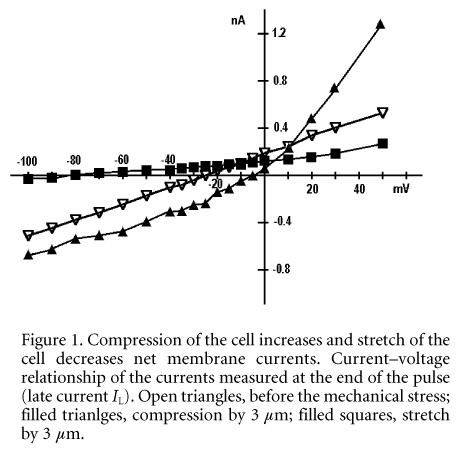Fibroblasts are the most numerous non-myocyte cells of the heart (Eghbali et al. 1988). They constitute a volume fraction that is 5-10 % of the heart cell volume (Anversa et al. 1980) and up to 75 % in the sinus node (Shiraishi et al. 1992). Microelectrode recordings from rat atrial multicellular tissue indicate that fibroblasts have resting potentials (E0) between -5 and -70 mV and input resistances (Rin) between 0.4 and 0.6 GΩ (Kiseleva et al. 1998). The fibroblast membrane potential is modulated by mechanical stretch and pressure (Kiseleva et al. 1998), a property that may contribute to the intracardiac mechanoelectrical feedback (Kamkin et al. 2002). It was supposed that compression of fibroblasts during contraction of the tissue leads to depolarization and stretch leads to hyperpolarisation. We tested this hypothesis and studied the nature of these effects.
Fibroblasts, which were isolated from rat hearts excised under ether anaesthesia were used for a voltage-clamp. The fibroblast was mechanically deformed between two patch pipettes, the first pipette was used for whole-cell clamp and served as a fix point. The second cell-attached pipette was laterally displaced with regard to the first pipette, thereby compressing or stretching the cell. The dependence of ionic current on membrane potential (I-V relationship) was measured by applying 20 pulses of 140 ms (0.5 Hz) that started from a holding potential of -45 mV. When the membrane currents flowing at the end of the pulse (IL) were plotted versus the respective clamp step potential, the resulting I-V curve intersected the voltage axis at the zero current potential (E0, corresponding to the resting potential of non-clamped cells). On average, the isolated fibroblast had an E0 = -37 ± 3 mV (n = 50), and the Rin = 514 ± 11 MΩ (n = 50) that resembled their counterparts in multicellular strips. Compression by 2, 3, or 4 mm shifted E0 to depolarization (Fig. 1, Table 1). The compression-induced difference (Ici) followed a modest outward rectification. Their amplitude increased with the extent of compression (Table 1) whilst their reversal potential (Erev) was nearly constant. The currents were carried by Na+, K+ and Cs+ ions, and were blocked by extracellular application of 8 mM Gd3+. The results suggest that compression induces a non-selective cation conductance (Gns). Stretch by 2, 3 or 4 µm hyperpolarized E0 (Fig. 1, Table 2). Stretch induced a positive difference current (Istr) with a Erev close to 0 mV (Table 2). Application of Gd3+ during continuous stretch shifted E0 to potentials as negative to EK (-97 ± 5 mV).
Ion selectivity, Erev and Gd3+ sensitivity of stretch-suppressed currents let us suggest that stretch reduces Gns. Cell dialysis with BAPTA (pCa > 8) or Ca2+/EGTA (pCa = 6) or with EGTA (pCa = 7) had no influence on the Ici or Istr, suggesting that Ca2+-dependent conductances are unlikely to contribute. The results could be modelled on the assumption of a compression-induced, stretch-deactivated Gns operating in parallel with a mechano-insensitive K+ conductance and a current due to electrogenic Na+ pumping.
All procedures accord with current National guidelines.

